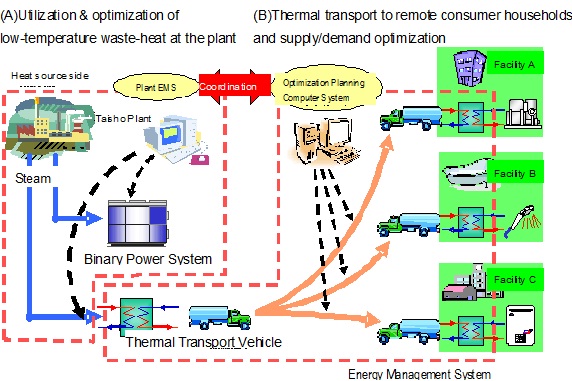Demonstrating Smart Community Urban Waste-heat Utilization in Osaka
Sep. 26, 2011
Tokyo, September 26, 2011 – Kawasaki Heavy Industries, Ltd., Osaka Gas Co., Ltd., the City of Osaka, and Osaka Prefecture announced today that their proposed joint project to make advanced use of incinerator and other forms of urban waste-heat was adopted by the Ministry of Economy, Trade and Industry (METI) as part of its 2011 Next-Generation Energy Technology Demonstration Initiative.*1 Under the project, low-temperature waste-heat generated at the Osaka City Environment Bureau's Taisho Incinerator Plant*2 will be used effectively within the plant, while incinerator heat will be supplied effectively to the neighboring community.
Steam generated by the incinerator at the Taisho Plant is currently used for power generation as well as the plant’s hot-water supply and heating. The current project takes on the challenge of demonstrating that the introduction of a wide-area energy management system will raise overall energy efficiency by 25% by optimizing heat-use within the plant and neighboring community.
■Project Overview
・The Taisho Plant uses incinerator heat to generate power, but currently disposes of low-temperature heat. To make effective use of this low-temperature heat, the project will install a binary power system*3 to improve energy-efficiency within the plant. (Part A in above diagram.)
・The project will also improve the utilization of incinerator heat by using thermal storage tanks to deliver heat to consumers*4 as far as 30 kilometers away. Whereas heat has typically been piped over short distances, the current project will assess the potential of delivering heat via thermal transport processes and examine efficient methods of delivery to multiple consumers. (Part B in above diagram.)
・An energy management system will also be installed to optimize heat utilization by the Taisho Plant and the neighboring community. The system is designed to improve energy efficiency by 25% over current use.*5
・The demonstration period is scheduled to start in 2011 and run for three years.
■Poject Diagram
 ■Areas of Responsibility
■Areas of Responsibility
・Kawasaki Heavy Industries, Ltd.
In addition to managing the overall project, Kawasaki will install a 250kW binary power system to make effective use of the low-temperature waste-heat that has gone unused at the Taisho Plant. Kawasaki will also build and assess the effectiveness of an energy management system within the plant that will optimize heat-use according to demand by the surrounding community and the Taisho Plant. (Part A in above diagram.)
・Osaka Gas Co., Ltd.
Osaka Gas will introduce thermal transport systems and demonstrate heat-use technology by providing incinerator heat to consumers at various distant locations. (Part B in above diagram.)
・Osaka City
Osaka City will undertake general coordination of project participants and preparations for the demonstration project, as well as project PR. It will also perform maintenance at the Taisho Plant where the demonstration is centered.
・Osaka Prefecture
Osaka Prefecture will work with Osaka City on the general coordination of project participants and preparations for the demonstration project, as well as project PR. It will also publicize the results of the demonstration widely.
The current project proposal builds upon the Osaka Smart Energy Project Survey led by Osaka Prefecture last year with support from the New Energy and Industrial Technology Development Organization (NEDO) under its 2010 Project for Establishing New Energy and Energy Conservation Visions at the Local Level.
・Other Participants
Hitachi Zosen Corporation
Hitachi Zosen will perform renovations on the Taisho Plant and provide related consulting services.
Kobelco Eco-Solutions Co., Ltd.
Kobelco will deliver the technology for the thermal transport system and provide related consulting services.
*1 This METI initiative provides support for the following demonstration projects working to build next-generation energy and social systems (smart communities).
・Demonstration projects, including those using emerging technologies, which seek to establish smart community-related technologies that can be shared regionally
・Demonstration projects that utilize untapped locally available energy resources as well as home-grown regional technologies and business models to enrich the diversity of social systems by building smart communities whose design is tailored to specific local needs and characteristics
The application process is administered by the New Energy Promotion Council (NEPC).
*2
Location: 1-11-24 Minami Okajima, Taisho-ku, Osaka-shi
Incinerator capacity: 300 t/day x 2
Built: July, 1980
Systems utilizing waste-heat:
・In-house power generator (3000kW)
・In-plant hot-water supply and heating system
*3 An energy-efficient power-generation system that uses low-temperature steam or water to vaporize a low boiling-point medium (approx. 80 degrees Celsius). Power is generated by a turbine as the medium expands.
*4 A system using trailers, etc. to transport thermal storage tanks and deliver heat to consumers located a distance away from a thermal source. The tanks are filled with the sweetener, erythritol, and kept at a latent heat (the temperature at which a solid converts to liquid or vapor, and vice-versa), making it possible to store three times the heat for a comparable volume of water.
*5 Comparison based on the parameters of the current project.





